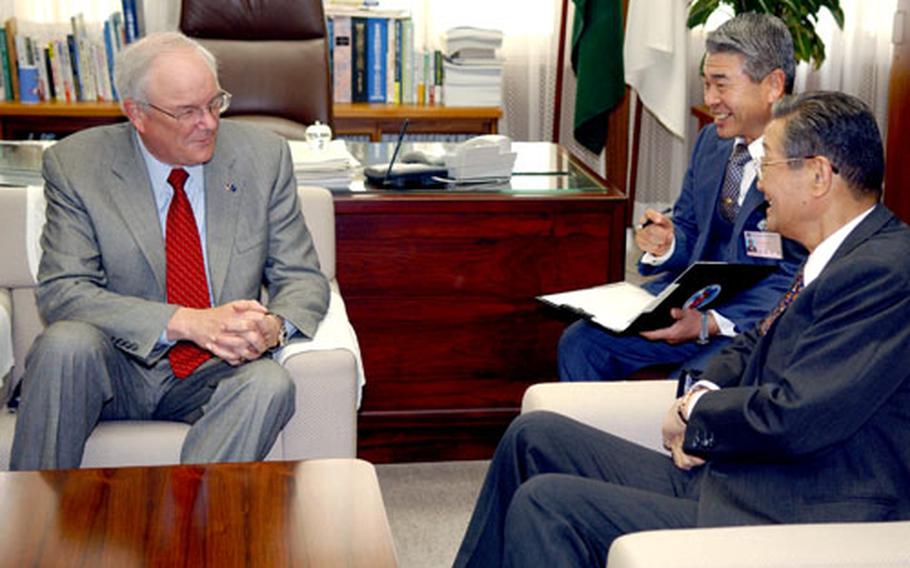
Secretary of the Air Force Michael Wynne talks with Misawa City Mayor Shigeyoshi Suzuki, front right, and the mayor’s translator Yukio Yamahata during the secretary’s weekend visit to Misawa Air Base. (Andy Bellamy / U.S. Air Force)
MISAWA AIR BASE, Japan — After meeting with at least 5,000 airmen while visiting Air Force bases in the Pacific, Secretary of the Air Force Michael Wynne said Sunday he will return to the Pentagon more educated about the mission and inspired by the region’s airmen.
The whirlwind tour began March 17 at Hickam Air Force Base, Hawaii, and hit bases in Guam, mainland Japan, Okinawa and South Korea before ending Sunday at Misawa.
Accompanied by his wife and PACAF Commander Gen. Paul Hester, Wynne said it was his first visit to many of the bases.
“You’re going out in order to bring a little bit of inspiration and ‘thank you’ from America to the … joint servicemen and -women who are serving around the world and you come away more inspired than perhaps you were able to deliver yourself,” he said in an interview with Stripes on Sunday morning.
Wynne found inspiration from airmen such as the four from Misawa with whom he had breakfast Sunday. They recently returned from an Aerospace Expeditionary Force deployment and shared stories of working with Japan Air Self-Defense Force members in Kuwait.
Newly minted airmen will be more prepared for these types of deployments, Wynne said, now that basic training is expanding by almost three weeks to include rifle and combat medic training. “It’s to make sure when they get into a deployed situation they … know how to react … and as they get into Army-coded missions, they are not uncomfortable,” he said.
The new training is still under design but “I believe they now get rifles on the second day (of basic training), for example, which never really used to happen,” Wynne said, noting that rifle training typically occurred at one’s first assignment.
During his Pacific tour, Wynne mostly spoke to large groups, fielding questions on topics such as the Air Force’s future direction, the new Air Force Smart Operations 21 program and Tricare.
The Defense Department recently proposed raising Tricare fees and deductibles for military retirees under age 65 and their dependents, as well as pharmacy co-pays for nonactive-duty beneficiaries. Wynne said speaking to airmen “gave me an opportunity to put to rest some of the rumors.”
“I think we made a classic mistake in economics when we established the Tricare co-pay in the sense that we did not index it to inflation,” he said. “While we set it very competitively in the mid-90s, by the time 2006 rolls [around] it is noncompetitive.”
Civilian employers encourage military retirees to stay with Tricare “because they see it to their economic advantage,” Wynne said. He said he hopes to convince Congress “that what we should do is … calculate correctly what would have been the index and restore the comparability between the private and the Tricare health systems.”
Wynne also spoke about the Air Force’s plan to streamline support functions in an effort to save money and improve efficiency that’s projected to cut about 40,000 jobs over the next six years. “We’re not bashful about saying that,” the secretary said. “It’s 40,000 full-time equivalents with the sharing of the burden across active, civilian, National Guard and reserves.”
Some cuts could come from reducing full-time guardsmen and reservists, Wynne said. For example: “A full-time guardsman is equivalent to six guardsmen who are not full-time but are contributing,” he said. “From trying to combine the experience and expertise of the National Guard, reserves and active, you will find pockets … that are redundant. We are growing the same talent, if you will, in two different places. I think that’s where we’re hoping to find our greatest success.”